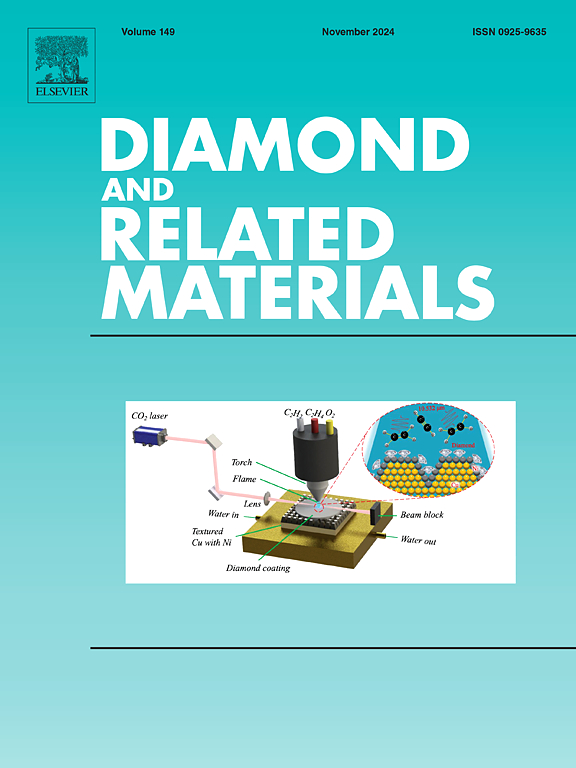用于钠离子电池的高性能柔性 CoFe2O4/N 掺杂碳纳米纤维复合负极材料
IF 4.3
3区 材料科学
Q2 MATERIALS SCIENCE, COATINGS & FILMS
引用次数: 0
摘要
石墨是传统的负极材料,但由于其比容量低、安全性差,不适合用于钠离子电池,因此有必要开发替代负极材料。通过电纺丝和煅烧制备了柔性 CoFe2O4 纳米粒子/N 掺杂碳纳米纤维薄膜。这种工艺的优点包括起始材料价格低廉、制备简单、适合商业化。CoFe2O4 固有的缺点,如电子导电性差和体积变化大,通过元素掺杂和与高质量碳材料形成复合材料得到了缓解。掺氮碳纳米纤维具有较大的比表面积和优异的机械性能,被用作材料的支撑骨架。这些纳米纤维限制了 CoFe2O4 在整个循环过程中的体积膨胀,并提高了材料中的离子扩散速度。具有较高理论比容量的纳米级 CoFe2O4 颗粒与掺氮碳纳米纤维导电骨架的最佳结合具有交联的三维结构,有利于电解质渗入电极。这种整合减少了钠离子的扩散距离,有效降低了材料的体积膨胀,并减少了电化学反应过程中对材料的损坏。在 0.1 A g-1 的电流密度下循环 200 次后,它的钠存储容量高达 365.7 mA h g-1。即使在 2 A g-1 的高电流密度下,容量也能保持在 176.3 mA h g-1。具有良好的循环稳定性。本文章由计算机程序翻译,如有差异,请以英文原文为准。

High-performance flexible CoFe2O4/N-doped carbon nanofiber composite anode materials for sodium-ion batteries
Graphite is traditionally used as an anode material but is unsuitable for use in sodium-ion batteries because it has a low specific capacity and poor safety characteristics, it is therefore necessary to develop alternative anode materials. Flexible CoFe2O4 nanoparticle/N-doped carbon nanofiber films were prepared by electrospinning and calcination. The advantages of this process included inexpensive starting materials, easy preparation, and suitability for commercialization. The inherent shortcomings of CoFe2O4, such as poor electronic conductivity and large changes in volume, were mitigated via elemental doping and the formation of composites with high-quality carbon materials. Nitrogen-doped carbon nanofibers with large specific surface areas and superior mechanical properties were used as the supporting skeleton of the material. These nanofibers limited the volume expansion of CoFe2O4 throughout the cycling process and increased the ion diffusion velocity in the material. The optimal integration of nanoscale CoFe2O4 particles, which possess a higher theoretical specific capacity, with a nitrogen-doped carbon nanofiber conductive framework featuring a crosslinked three-dimensional structure facilitated the infiltration of the electrolyte into the electrode. This integration reduced the diffusion distance of sodium ions and effectively reduced the volume expansion of the material, as well as damage to the material during the electrochemical reaction. After 200 cycles at a current density of 0.1 A g−1, it provided a high sodium storage capacity of 365.7 mA h g−1. The capacity was maintained at 176.3 mA h g−1 even at a high current density of 2 A g−1. Exhibits good cycle stability.
求助全文
通过发布文献求助,成功后即可免费获取论文全文。
去求助
来源期刊

Diamond and Related Materials
工程技术-材料科学:综合
CiteScore
6.00
自引率
14.60%
发文量
702
审稿时长
2.1 months
期刊介绍:
DRM is a leading international journal that publishes new fundamental and applied research on all forms of diamond, the integration of diamond with other advanced materials and development of technologies exploiting diamond. The synthesis, characterization and processing of single crystal diamond, polycrystalline films, nanodiamond powders and heterostructures with other advanced materials are encouraged topics for technical and review articles. In addition to diamond, the journal publishes manuscripts on the synthesis, characterization and application of other related materials including diamond-like carbons, carbon nanotubes, graphene, and boron and carbon nitrides. Articles are sought on the chemical functionalization of diamond and related materials as well as their use in electrochemistry, energy storage and conversion, chemical and biological sensing, imaging, thermal management, photonic and quantum applications, electron emission and electronic devices.
The International Conference on Diamond and Carbon Materials has evolved into the largest and most well attended forum in the field of diamond, providing a forum to showcase the latest results in the science and technology of diamond and other carbon materials such as carbon nanotubes, graphene, and diamond-like carbon. Run annually in association with Diamond and Related Materials the conference provides junior and established researchers the opportunity to exchange the latest results ranging from fundamental physical and chemical concepts to applied research focusing on the next generation carbon-based devices.
 求助内容:
求助内容: 应助结果提醒方式:
应助结果提醒方式:


